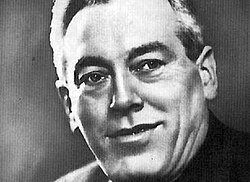|
Julien Lahaut
Julien-Victor Lahaut (6 September 1884 – 18 August 1950) was a Belgian politician and communist activist was president of the Communist Party of Belgium from 1945 to 1950. An important figure during the German occupation of 1940–44, he became a vocal advocate for the abolition of the Belgian monarchy during the post-war Royal Question. His assassination in August 1950, at the height of the crisis, was linked to anti-communist and royalist elements inside the Belgian intelligence services by a team of historians in 2015;[1] however, the murder remains officially unsolved. Political backgroundDuring the First World War, Lahaut served in the Belgian army and was part of the Belgian Expeditionary Corps in Russia, fighting on the Eastern Front along with Imperial Russian forces.[2] After his return to Belgium, he joined the new Communist Party of Belgium. He soon became a Communist deputy and was later the party's chairman. He was particularly vocal in his republican sympathies. During the German occupation of Belgium (1940–44), as the head of the Communist Party, Lahaut led the Strike of the 100,000 in May 1941 and was arrested. After failing to escape from captivity in the Citadel of Huy, he was deported to Mauthausen concentration camp. Although suffering considerable health effects, he was still alive when the camp was liberated by the Allies in 1945. Royal Question and assassinationThe aftermath of the Liberation of Belgium saw a prolonged period of political crisis, known as the Royal Question, over whether King Leopold III, who was living in exile due to his decision to surrender to Nazi Germany in 1940, could return to his position as monarch. The crisis came to a head in 1950, when Leopold returned to Belgium, but quickly had to let his son Baudouin assume royal duties. (He would abdicate in Baudouin’s favour a year later.) On 11 August 1950, Baudouin took the constitutional oath as regent before a joint session of both chambers of Parliament. During the proceedings, one of the communist deputies present shouted “Vive la république !” (“Long Live the republic!”). Lahaut was reported to have been the deputy responsible, though in the confusion of the moment this remains unconfirmed. A week later, on 18 August 1950, Lahaut was assassinated by two unknown gunmen outside his home in Seraing. Coming at the end of the constitutional crisis, Lahaut's death caused widespread outrage, especially in left-wing circles. Strikes were organized all over the country, while 300,000 people attended his funeral. The Communist Party newspaper Le Drapeau rouge carried the headline: “A monstrous crime! Our dear comrade Julien Lahaut, leader of the Communist Party, was assassinated last night by the Leo-Rexists".[note 1][3]  François Goossens, a Belgian royalist, was later identified as one of the murderers, although it is uncertain whether he fired the actual shots.[4] A similar incident happened in 1993 when Baudouin’s brother and successor Albert II took the oath: libertarian Jean-Pierre Van Rossem shouted “Vive la république d'Europe, vive Julien Lahaut!” (“Long live the republic of Europe, long live Julien Lahaut!”). On 19 July 2012, the Senate agreed to consider a legal proposal to extend funding for a historical study on the assassination.[5][6] On 17 August 2012, the minister Paul Magnette announced a federal contribution of €320,000 to the study.[7][8][9] In 2015, a team of Belgian historians under the supervision of Emmanuel Gerard concluded that Lahaut's assassination had been orchestrated by anti-communist elements inside the intelligence services, with a prominent role for the agent André Moyen.[1] Despite this, no one was ever sentenced for the murder. In popular cultureIn 1951 editorial cartoonist André Jacquemotte drew a biographical comic strip about Julien Lahaut's life, which ran in the magazine Jeunesse Belgique.[10] The left-wing playwright Jean Louvet authored a play about Lahaut's assassination entitled L'homme qui avait le soleil dans sa poche (lit. 'The Man who had the Sun in his Pocket') which was published in 1982. See alsoNotesReferences
Sources
External links
|
||||||||||||||||||||||||||||||||||||||
Portal di Ensiklopedia Dunia
